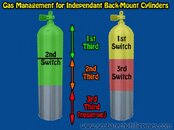It's my understanding that by adding another HP hose and SPG, you're not only adding another couple of failure points but the task loading of monitoring additional equipment. Since I have seen several hose/reg failures even in my relatively short diving career, I'm inclined to believe that statistically speaking, the addition of a hose/gauge is more likely to introduce failure than introducing an isolator.
So the argument goes - higher chance of losing 50% of your gas vs lower chance of losing 100% of your gas. This assumes you can reach the valves (but seriously, if you can't reach the valves, what the hell are you doing with a manifold?), and can shut them down in a modest amount of time (again, if you can't do this, why the hell are you using a manifold?). In this situation, in order to lose 100% of your gas, you would need a failure of the isolator that would vent to the outside at a rapid rate regardless of position (virtually impossible), or a second failure that would compound a stuck-open isolator.
Personally, even diving open water, there are a hundred thousand things that are statistically and realistically more likely to kill me than the failure of an isolator. The same can be said about losing 50% of your gas with independent doubles. I like knowing that if I do have a failure, I can quickly and safely shut down the offending post and still have the rest of my gas to fix other problems, get out, ponder the meaning of life, or whatever else I need to do. That is a preference, and a risk I assume given the incredibly low odds of the failures needed to compromise the system. That's my argument for using them, and there are other very well stated arguments for the other system as well. If your dive plan does not necessitate access to 100% of your gas throughout the length of your dive, then use whatever system your heat desires, just know HOW to use it! I'm starting to get the feeling you're looking for validation that independent doubles are in some way superior - and I really don't think you're going to find it here.
So the argument goes - higher chance of losing 50% of your gas vs lower chance of losing 100% of your gas. This assumes you can reach the valves (but seriously, if you can't reach the valves, what the hell are you doing with a manifold?), and can shut them down in a modest amount of time (again, if you can't do this, why the hell are you using a manifold?). In this situation, in order to lose 100% of your gas, you would need a failure of the isolator that would vent to the outside at a rapid rate regardless of position (virtually impossible), or a second failure that would compound a stuck-open isolator.
Personally, even diving open water, there are a hundred thousand things that are statistically and realistically more likely to kill me than the failure of an isolator. The same can be said about losing 50% of your gas with independent doubles. I like knowing that if I do have a failure, I can quickly and safely shut down the offending post and still have the rest of my gas to fix other problems, get out, ponder the meaning of life, or whatever else I need to do. That is a preference, and a risk I assume given the incredibly low odds of the failures needed to compromise the system. That's my argument for using them, and there are other very well stated arguments for the other system as well. If your dive plan does not necessitate access to 100% of your gas throughout the length of your dive, then use whatever system your heat desires, just know HOW to use it! I'm starting to get the feeling you're looking for validation that independent doubles are in some way superior - and I really don't think you're going to find it here.






